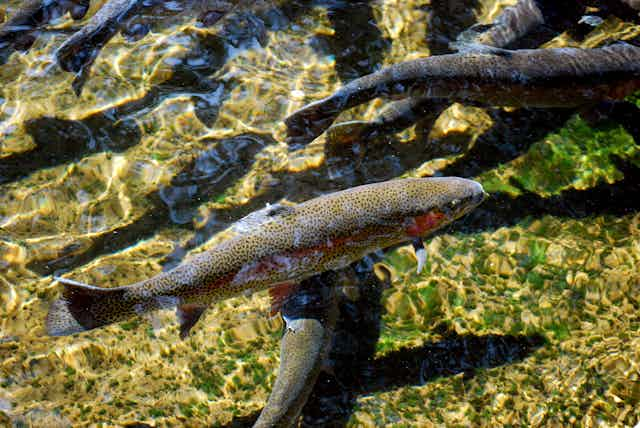Developed countries are producing policies to reduce the flow of invasive species and control or eradicate existing invasions. But most developing countries are under-resourced to tackle either aspect without help.
Emerging economies, such as Brazil, Russia, India, China, and South Africa (BRICS), are responsible for donating many of the world’s invasive species that have the potential to reach nearly all terrestrial biomes. These are natural areas defined by the communities of plants and animals present. Countries must urgently implement a proactive “facilitated network” to build capacity and stimulate effective, appropriate invasion science in BRICS nations.
In our paper we explored why the world needs BRICS countries to build capacity to manage invasive species. We chose the BRICS set of countries because they have a very real potential to be the source of the 21st century’s new invasions.
This is because they make a sizeable contribution to world trade. The link between the quantity of trade and the introduction of invasive species has been well established. Trade results in many more unintentional movements, from toads that sneak into containers of furniture to organisms that attach themselves to the outside of ships which move the goods around.
It also involves the intentional movement of plants and animals in the horticulture and pet industry. Once established in new environments, a proportion of these become invasive.
Read more: Why the habit of wanting to own a piece of nature's beauty needs to be broken
The other reason we focused on BRICs countries is that they are home to a large proportion of the world’s biodiversity: the Brazilian Amazon, Cerrado, and Atlantic Forest; Russia’s Caucasus and Far East; Indian Western Ghats, Himalayas; Southwestern China; and South Africa’s Cape Floristic Region, Succulent Karoo, and Maputo-Pondoland-Albany.
To protect these, and to manage the growing threat to biodiversity from anthropogenic drivers – that is action by humans – we argue for a global network of scientists who specialise in invasions within and between the BRICS countries. The aim would be to train the next generation of invasion scientists in order to continue to provide evidence-based recommendations for policy makers.
Current and future BRICS invasions
BRICS countries are already plagued with some of the world’s worst invasive species. These include:
The Harlequin Ladybird is native to Central and East Asia, but has been introduced all over the world including Brazil and South Africa.
Rainbow Trout are native to North America, but are now present in Brazil, Russia (which also has native populations), India, China and South Africa.
Black Wattle is native to Australia, but is now invasive in Brazil, India, China and South Africa.
and Castor Oil Plants from northeastern Africa, which have been introduced around the world, becoming invasive in Brazil, India, China and South Africa.
BRICS countries are also the sources of some invasive species with the highest impact. These include:
The Tree of Heaven, native to China but invasive in India and South Africa.
Strawberry Guava, native to Brazil but invasive in India, China and South Africa.
The House Crow, native to India and China but invasive in South Africa.
and the African Clawed Frog, native in South Africa but invasive in China.
Two important factors in alien species becoming established, and subsequently becoming invasive, are how many arrive and whether there’s a matching climate. The fact that all five BRICS countries are growing their global trade presence means that the number of alien species arriving in foreign climes is likely to rise.
As far as the matching climate factor is concerned, our analysis by researchers from all of the BRICS countries found that the climatic areas found in each of the countries matched all but the very coldest places on earth. This means that species originating from BRICS countries are very likely to find suitable climatic space elsewhere in the world.
The good news is that there’s a solution, and it’s relatively cheap.
The recommendation that we set out is much cheaper than removing invasive species, which is estimated to have cost the UK alone US$1.7 billion in 2010.
BRICS countries are already on the same page: all have signed up to the Convention on Biological Diversity. It’s aimed at preserving global biodiversity. This includes eliminating the threat from invasive species.
The solution
South Africa has established the world’s first Centre of Excellence for Invasion Biology by linking the country’s existing invasion scientists in a facilitated network. This could be replicated by the other BRICS countries.
Achievements of the Centre for Invasion Biology include:
Approximately 20 graduates annually (including at masters and PhD level),
Of the 340 alumni, 33% continue in academia, 17% move into governmental and implementing agencies, 5% work in NGOs, and other graduates work in sectors relating to their fields of study.
Nearly 10% of references cited in Aichi Target 9, an agreed target of the Convention on Biological Diversity, were published by the centre.
Produced the world’s first report on biological invasions and their management, and the world’s first framework of indicators for reporting on biological invasions at a country level.
The centre’s model of a facilitated network of invasion biologists is reproducible in the other BRICS countries. Each country already has excellent invasion scientists, but they aren’t linked into a network.
The facilitated network approach is different to traditional research institutes. This is because it gains strength from having its members distributed across the different biomes within each country. This means that they can offer biogeographic, cultural, and institutional insights from local invasions within their working context.
In addition, capacity built by new networks can quickly be taken up by governmental and nongovernmental organisations, providing the know-how to tackle existing and emerging problems with invasive species.
Investing in facilitated networks in all of the BRICS countries would also result in a global network of invasion scientists that would benefit all countries that trade with these emerging economies, allowing economic growth without the future threat.

